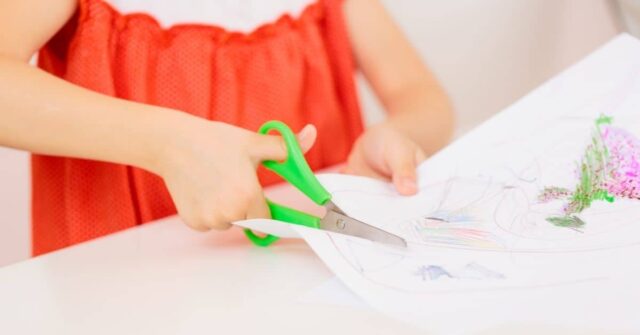Wonder if your kid is a righty or lefty? Learn when your child should have clear hand dominance and why it matters. Plus, easy activities to help your child establish hand dominance.
Affiliate links used below. See our full disclosure.
I met my little friend Adam* when he had just turned 6. He was in kindergarten and his family and teachers were worried about his cutting, handwriting, and eating.
The problem was that Adam switched hands every single time he did any of these activities!
His mom thought he was left-handed. His teacher insisted that he was right-handed! And, Adam didn’t know which hand he liked to use better.
He had trouble writing his name, and his food often ended up dumped in his lap when he was eating.
When he was coloring or cutting, he would often switch hands right in the middle of the activity. It was seemingly impossible to know which hand was more dominant.
Was Adam right handed or left handed?
Does Hand Dominance Matter?
Hand dominance may not seem important at first, but as your child gets older, it becomes more important. Each and every time your child practices picking up a pencil and making marks with the same hand, the more skilled they become at it.
While writing, your child’s brain needs to think about which fingers to use, how strong to grasp the pencil, how hard to push the pencil into the paper, the motions needed to make the letters, and then they need to think about what they want to write.
That’s a lot!
Writing and other skills like cutting are actually really specialized and precise skills.
The best way for your child to learn to do these specialized skills is by specific practice with one hand, over and over again! As your child practices, the two sides of the brain make new connections and your child becomes more skilled.
And, they establish hand dominance!

When You Should Expect Hand Dominance In Your Child….?
Hand dominance can start showing up as early as two, sometimes even a bit earlier. You might start noticing that your toddler is picking up their spoon with a certain hand. Or, you find that more times than not, they use their right hand to color the page.
This is the beginning of hand dominance.
Although, they may not consistently use the same hand all the time at this age. As your toddler gets older, you may notice a pattern. Are they always using their left hand? Or when they use their right hand, is your toddler more accurate in getting the food to their mouth?
Our toddlers usually start to notice that one hand is more accurate than the other too. Even if it happens subconsciously.
Over time, this will slowly turn into hand dominance. Hand dominance is usually established between the ages of 4-6. Teachers expect hand dominance to be solidified in kindergarten. .
Righty or Lefty? How to Tell Which Hand is Dominant?
The trouble is, like my friend Adam, sometimes the answer isn’t always clear cut. Some kids will switch hands for every single activity. It can be difficult to see a pattern!
When that happens, how do we tell which hand is dominant? Which hand do we encourage them to use when they’re coloring a picture or trying to zip their jacket?
As an occupational therapist, I can tell you that there are a few ways to help us decode this mystery:
- When coloring, place the crayon directly in front of the middle of your child’s body. Then, be quiet. Don’t say a word, don’t encourage one hand over the other, just observe. Which hand does he use to pick up the crayon? Do this many times over the course of a week. Take notice of a pattern, if you see one, it’s likely their dominant hand!

- For older kids, have them write their name with both hands. Which is more legible? This can give us a big hint!
- Observe, and then, observe some more. Does your child switch hands during activities? When they do switch hands, does it happen randomly or when one hand is tired? Or, does it happen when they cross the middle of the body? Noticing when your child switches could give you important clues.
- Look at family history. I always ask the parents if there are any lefties in the family. Most people are right-handed. But, if both parents are left-handed, then almost always, the kiddo is going to be left-handed too. This can be yet another clue.
Factors That Interfere With Developing Dominance
What I didn’t tell you, was that my friend Adam had a really complicated start to life. Soon after he was born, he had a liver transplant and had spent most of his first year in the hospital.
Even though those events seem to have no connection to hand dominance, they really interfered with his dominance development.
Does your child have any underlying concerns that might make developing a dominant hand difficult?
Does your child have a medical history? Different diagnoses like sensory processing, autism, ADHD, or down syndrome can interfere with developing hand dominance. Was your child premature? A hospital stay, especially a long one, can also interfere with development.
Retained reflexes can also make sitting down to write just plain difficult for kids.
Your child was born with certain reflexes that help them stay alive during their first year of life. Sometimes these reflexes can stick around for longer than they’re supposed to.
If your child’s head wants to automatically turn every time they color because of a reflex that’s still present (and shouldn’t be), that’s going to make writing and developing hand dominance much more difficult!
Sometimes kids can have crossing midline difficulties. You can think of that as an imaginary line in the center of your child’s body. When they use one hand to do work on the opposite side of their body, they’re crossing midline.
If your child has difficulty crossing midline, they may frequently switch hands during any fine motor activity.
You might see them use their left hand when they’re coloring on the left side of the paper and their right hand when they’re coloring on the right side.
This can happen when they’re feeding themselves too.
Don’t Confuse Hand Dominance With Hand Weakness
Hand weakness is another issue that can hide hand dominance, which happens a lot. Your child starts off coloring with their right hand, then their right hand gets too tired, so they switch to their left.
The problem is actually that their hand needs to be strengthened, not that they haven’t developed hand dominance.
5 Easy Activities to Encourage Hand Dominance
After lots of observation, you will start to see a pattern in your child. One hand is likely stronger and works more accurately than the other, even if just slightly! Now that you have an idea which hand is likely dominant, you can work on specific activities to strengthen their right or left handed dominance.
With each of the activities below, I like to help kiddos differentiate between their two hands, the dominant hand and the helper hand.
Putting a sticker on their dominant hand can be a great way to remind them which hand to use for the actual work. The helper hand is the one that “helps” get the job done by stabilizing.

- Cutting: This is one of the best hand dominance activities because it uses both hands and the helper hand has a big job. When first starting to teach your child to cut, you can use playdoh and playdoh scissors. They’re safe and easy to use.
Have your child use their helper hand to hold the playdoh still and then use her dominant hand to do the cutting.
When they’re ready to move on to real scissors, I love these self opening ones or these loop ones.
They’re great for learning. One of my favorite first activities is to have the child make confetti by cutting strips of paper into tiny pieces. It sure can make a mess, but is a great way to get them excited about using their dominant hand! Give them a big tray to cut over to help keep the mess to a minimum.

- Throwing or bowling a ball: This is a great activity because it feels less like schoolwork to kids and more like play. You can play catch, throw to a target to knock things over, or set up some bowling pins.
This helps strengthen their dominant arm and hand while they feel like they’re playing!
- Scooping and pouring: Sensory bins or sandboxes are perfect for scooping and pouring, and kids often have no idea they’re working on hand dominance.
Start with a big bin and fill it with material like dried rice and beans, then add in cups, small scoops, shovels, tongs, and a few toys. Then, let them scoop and pour. You can encourage your kiddo to use their dominant hand to do the pouring and their helper hand to hold the container still.
- Opening and closing containers: Kids usually find this activity surprisingly fun! I like to take a whole bunch of different sized containers and fill them with different toys, stamps, or stickers, then close them up.
They use their dominant hand to twist or pull the top off and their helper hand stabilizes the container. The little prizes can be really motivating!
- Playdoh: Playdoh doesn’t feel like work. It can be great fun to sit next to your child and play right along with them. Squeezing and squishing playdoh with their dominant hand helps to strengthen it.
Using their helper hand to stabilize the playdoh while they use a plastic knife to cut, reinforces just how helpful a helper hand can be! They can also roll it into a ball, make pancakes, or make a snake. The possibilities are endless.
Now it’s your turn! Let us know what activities you’re excited to try with your child or if you have a hand dominance activity they already love so we can all be inspired with more ideas!
Andrea Timler is a licensed occupational therapist and part of the Your Kid’s Table Team. She has over 7 years experience with expertise in development and feeding in babies, toddlers, and children. Andrea also has 4 kiddos of her own at home.
More Developmental Activities for Your Child
3 Quick Tricks That Improve Fine Motor Skills
5 Fine Motor Activities to Get Kids Ready for School
Visual Perceptual Activities: 4 Ways to Boost Your Kids’ Development
Easy Obstacle Course to Improve Handwriting

As always- super information!!!
I always enjoy the wealth of knowledge provide and share to family and student families
Hi Emmi,
We’re so glad that you’ve found it helpful!!! Thanks for sharing that with us 🙂
Best,
Andrea
My almost 6yo son has spent the past 6 months in OT for sensory issues and for this very reason! He appears to be a lefty and writes and colors with his left hand. He also kicks with his left foot (mostly) and throws a ball with his left hand. BUT he only eats with his right hand (always, his whole life), and he isn’t consistent with cutting with his left hand. He also will use his right hand as his dominant hand when building Legos and doing building activities. His handwriting is not terrific (but he just started K, so hopefully that will improve) and, overall, his motor skills are good but not great. His therapist honestly didn’t seem that worried about the whole thing, but I always wonder if it will be trouble down the road. Should I be encouraging him to switch only to his left hand for everything? Or should I not be making an issue out of it?
Hey Linda,
It sounds like he is doing most things with his left hand, which is great! Since it is only a few activities that he does with his right hand, you might encourage him to use his left, but not make a big deal about it. I hope that makes sense! It sounds like most activities that he’ll be doing in school, he consistently uses his left hand for, so those will help him develop his handwriting skills as well. I hope that helps!
Best,
Andrea